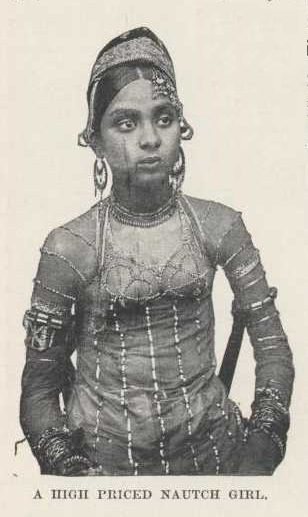Twain witnessed nautch dancing in two locations while visiting Bombay. He first mentions it during his visit to a ceremony in Byculla:
"The most gorgeous costumes present were worn by some children. They seemed to blaze, so bright were the colors, and so brilliant the jewels strewing over the rich materials. These children were professional nautch-dancers, and looked like girls, but they were boys. They got up by ones and twos and fours, and danced and sang to an accompaniment of weird music. Their posturings and gesturings were elaborate and graceful, but their voices were stringently raspy and unpleasant, and there was a good deal of monotony about the tune."
His second viewing of nautch dancing was at a betrothal ceremony.
But at last we turned a corner and saw a great glare of light ahead. It was the home of the bride, wrapped in a perfect conflagration of illuminations,—mainly gas-work designs, gotten up specially for the occasion. Within was abundance of brilliancy—flames, costumes, colors, decorations, mirrors—it was another Aladdin show.
The bride was a trim and comely little thing of twelve years, dressed as we would dress a boy, though more expensively than we should do it, of course. She moved about very much at her ease, and stopped and talked with the guests and allowed her wedding jewelry to be examined. It was very fine. Particularly a rope of great diamonds, a lovely thing to look at and handle. It had a great emerald hanging to it.
The bridegroom was not present. He was having betrothal festivities of his own at his father's house. As I understood it, he and the bride were to entertain company every night and nearly all night for a week or more, then get married, if alive. Both of the children were a little elderly, as brides and grooms go, in India—twelve; they ought to have been married a year or two sooner; still to a stranger twelve seems quite young enough.
 A while after midnight a couple of celebrated and high-priced nautch-girls appeared in the gorgeous place, and danced and sang. With them were men who played upon strange instruments which made uncanny noises of a sort to make one's flesh creep.
A while after midnight a couple of celebrated and high-priced nautch-girls appeared in the gorgeous place, and danced and sang. With them were men who played upon strange instruments which made uncanny noises of a sort to make one's flesh creep.
One of these instruments was a pipe, and to its music the girls went through a performance which represented snake charming. It seemed a doubtful sort of music to charm anything with, but a native gentleman assured me that snakes like it and will come out of their holes and listen to it with every evidence of refreshment and gratitude. He said that at an entertainment in his grounds once, the pipe brought out half a dozen snakes, and the music had to be stopped before they would be persuaded to go. Nobody wanted their company, for they were bold, familiar, and dangerous; but no one would kill them, of course, for it is sinful for a Hindoo to kill any kind of a creature.